Compared to traditional wired networks, WLANs have more moving parts that can impact the end user experience. When a performance issue affects the end users, the engineer has to quickly understand if the problem is caused by the wireless client, the quality of the wireless signal, the wireless infrastructure, the wired infrastructure, including the Internet, or the application.
Wireless controllers and other monitoring systems that pull data from access points are indeed necessary but not sufficient for determining the root cause of an issue. Engineers need to complement metrics from the wireless infrastructure with signal strength, signal quality, etc. from wireless clients. This data will quickly help pinpoint the root cause that is impacting the end user experience.
This article outlines some of the most common performance degradation issues in WiFi networks and how to detect them so they can be resolved quickly. We answer the questions that network engineers struggle with on a daily basis:
- How do I know if it’s a network issue or an application issue?
- How do I validate connectivity to my WiFi network?
- How do I measure the speed of my WiFi network?
- How can I validate my WiFi signal coverage?
- How can I monitor my remote branch locations’ WiFi?
We also discuss a deployment scenario that can be adopted by network engineers in planning and deploying a system that monitors wireless infrastructure from the client perspective with the goal of reducing the detection and resolution time of WiFi performance issues.
NetBeez WiFi Network Monitoring Solution
Most network monitoring solutions are looking at the situation from the network viewpoint. It’s all practical information, but what happens when all systems look healthy and the users can’t connect to the WiFi, or an application is too slow?
The reality is that traditional tools don’t provide information about users’ digital experience. The issue is more acute for users at remote locations who have no local IT support to diagnose and fix their WiFi connectivity or performance issues. All they can do is submit a trouble ticket and wait for help.
NetBeez flips the script and lets you see what the end users are experiencing. The solutions relies on network monitoring agents (“Beez”) that simulate end user activity by continuously testing network services and reporting back to a central server ( “BeezKeeper”).
By polling information from the NetBeez agents, a network engineer can determine when there is an outage and whether it’s an outage that is detected by one or multiple locations. The solution also can determine whether the problem is with the network or the application.
The WiFi Monitoring Sensors and the Client Endpoints
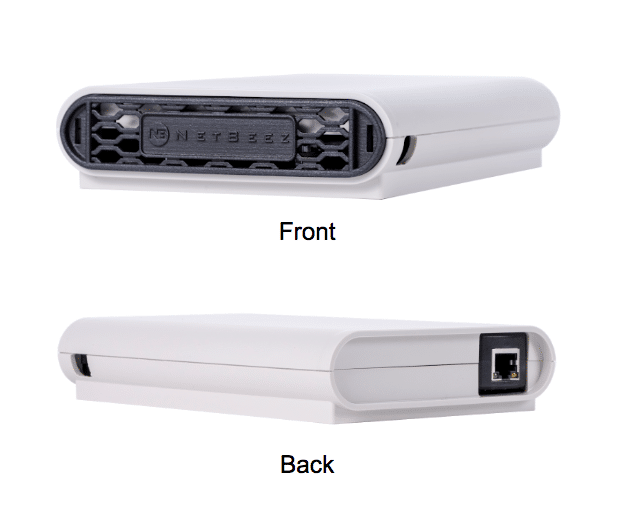
The NetBeez agents can be:
- Hardware sensors equipped with PoE (see picture above)
- Software clients for Windows, Macintosh, or iGel operating systems.
The data collected as a result of these tests provides end-to-end verification of reachability and performance from the user’s perspective.
The NetBeez solution also checks that the network can successfully forward traffic, which in turn verifies the application delivery from the data center to remote branch locations. The NetBeez WiFi agent performs these tasks 24×7 to constantly test availability for the end users.
Time-to-resolution of technical issues is a critical metric for many organizations. NetBeez provides metrics from a user perspective that can help shorten the time it takes to detect and resolve issues that are disruptive to the business.
The wireless Beez are capable of running real-time performance tests both on the wireless and on the wired interfaces. That means that network and application performance data collected by the agents on the wireless interface can be compared to the same data collected on the wired one. Not only, but the WiFi agents can also monitor up to four different SSIDs in a round-robin mode (SSID hopping), record the time that it takes to connect to a network, perform SSID scans, and run ad-hoc packet captures on the wireless interface.
Network Performance Tests
The NetBeez agents support two types of performance monitoring tests: real-time and scheduled tests:
- The real-time tests are called so because they continuously run based on an interval specified in seconds; real-time tests include ping, DNS, HTTP, traceroute, and path analysis.
- The scheduled tests run less frequently and according to a user-defined schedule (similar to a cron job) and include iperf, network speed, VoIP.
Dashboard users can also run both real-time and scheduled tests ad-hoc to troubleshoot network or application issues on the spot.
Real-Time Network Monitoring Tests
Real-time tests can run both on wired and wireless interfaces.
| PING | TCP-Based Ping | DNS | HTTPS |
|---|---|---|---|
| Availability Packet Loss Round-Trip Time DSCP marketing MTU and DF setting | Availability TCP response time Failure rate DSCP marking MTU and DF setting | Service availability DNS lookup timeF ailure rate | Service availability HTTPS GET time Failure rate |
| Traceroute | Path Analysis |
|---|---|
| Number of hops to destination TCP/UDP/ICMP protocol Hop-by-Hop RTT Path-MTU discovery DSCP marking Destination TCP port | Number of hops to destination UDP protocol Hop-by-Hop Geo Location, ASN, RTT min/max/average ECMP discovery |
Scheduled Tests
Scheduled tests only run on the wireless interface.
| Iperf | Network Speed | VoIP |
|---|---|---|
| TCP/UDP throughput Custom TCP/IP ports DSCP marking Jitter (UDP) Packet Loss (UDP) Multicast (UDP) Retransmissions (TCP) Parallel Streams (TCP) Reverse mode | Download speed Upload speed Latency | Mean Opinion Score Packet Loss Jitter Codecs supported: G711, G729, G723, G726, G728 |
NetBeez Agents WiFi Metrics
The NetBeez agents report the following metrics in real-time and historical mode:
- Sent and received bits per second
- Signal strength and link quality
- Associated channel and BSSID number
- Bit rate established with the access point
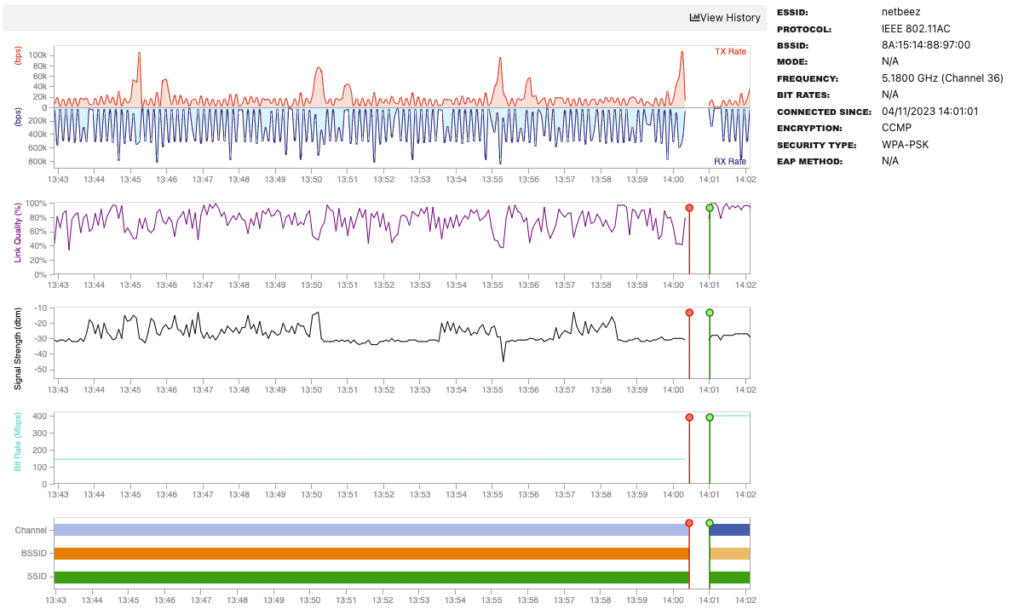
In addition to the wireless metrics, the user can have an agent perform a survey of SSIDs that are broadcasting in the area where the agent is installed.
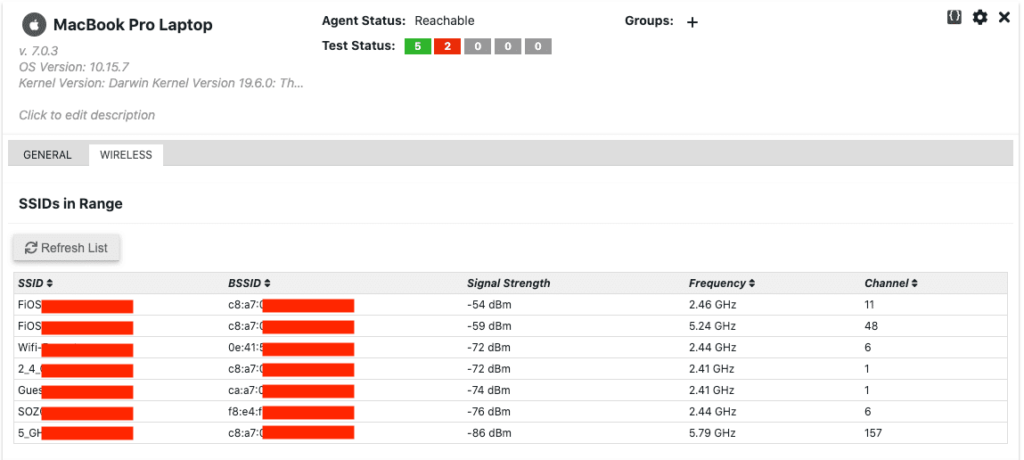
SSID Hopping, Connection Timing, and Packet Capture
SSID hopping enables a wireless monitoring sensor to sequentially test up to four different WiFi networks in a round robin fashion. The sensor will connect to the first SSID, record the time to connect, run monitoring tests, and then move on to the next network. The benefits of SSID hopping include detection of problems with AP association, radius authentication, and DHCP addresses availability. WiFi connection timing is also available when the agent is monitoring one SSID.
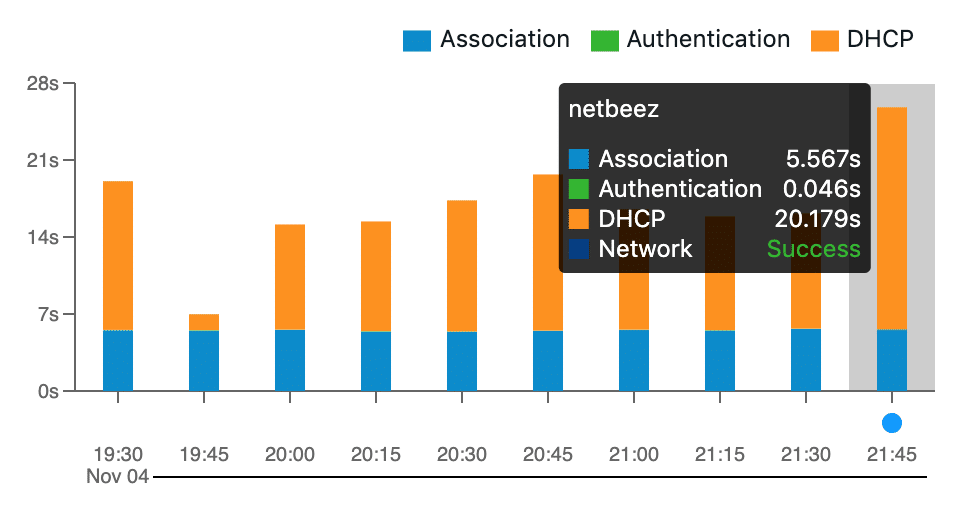
Dashboard users can also run wireless packet captures in ad-hoc mode. The user can select the test duration, radio band, and other parameters such as hopping interval and custom tcpdump parameters. Once the packet capture is completed, the agent sends a pcap file for download via the dashboard.
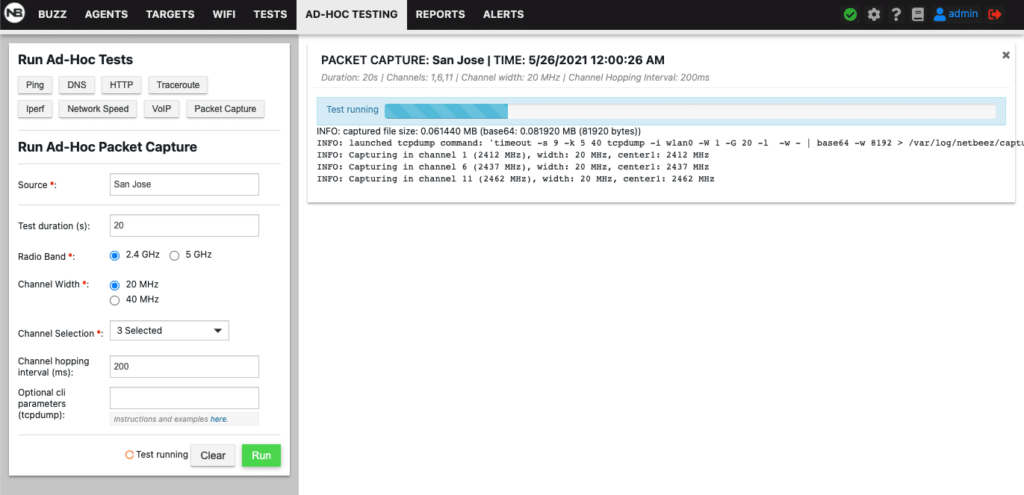
Wireless Sensors Deployment Guidelines
One important step in the setup of WiFi monitoring from the client perspective is the location of the monitoring probes. To correctly choose a location, the wireless engineer has to pre-define the primary goal of the monitoring before the deployment takes place. Is the primary goal to verify that WiFi clients can successfully authenticate and associate to the network, or does the wireless engineer also want to monitor the signal coverage at remote sites? The answer to this question will determine the number of sensors deployed per location as well as the complexity of the project.
A good practice is to have at least one WiFi monitoring sensor per location – benefits include proactive outage detection and validation of configuration changes without having to drive to the remote site to make sure that everything works, or worse, leaving it up to the users to find problems. Also, a remote WiFi sensor will provide real-time and historical data of the overall network performance at the remote location.
Some organizations might deploy more sensors based on coverage and their own monitoring needs. For example, a hospital with a dense population of wireless devices might choose to deploy several wireless sensors per floor. Or, a university wanting to understand its WiFi coverage in times of high usage might deploy multiple Beez in an auditorium or library. If you want to learn more about this, read our deployment guide for wireless sensors.
Conclusion on WiFi Network Monitoring
Traditional network monitoring primarily looks at the health and status of major components such as servers, routers and switches. NetBeez complements that collection of data with network monitoring from the client perspective. Proactive monitoring enables quick determination of the root cause of a problem and a shorter time to resolution of the issue.
Do you want to learn more about NetBeez and monitoring WiFi networks from the client’s perspective? Schedule a demo now!





